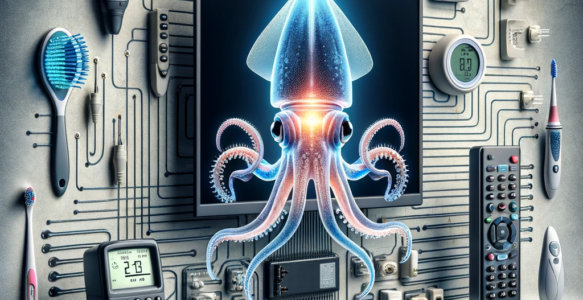
The Magic of Biomimicry
When we look to nature for inspiration, we often uncover elegant solutions to complex problems. Otto H. Schmitt tapped into this source of innovation with his revolutionary design—the Schmitt trigger. Inspired by how squid nerves process information, Schmitt created a device now indispensable in modern electronics.
What is the Schmitt Trigger?
The Schmitt trigger is a special type of circuit that filters unwanted noise from signals, allowing electronic devices to make clear decisions. Think of it as a gatekeeper that only allows clear, meaningful information to pass through. This function is crucial for the reliability and precision of electronic devices.

Credit: Schmitt trigger – Wikipedia. Comparison between a standard comparator (A) and a Schmitt trigger (B) when processing a noisy analog input signal (U) is demonstrated.
The green dotted lines represent the circuit’s transition thresholds. The Schmitt trigger effectively filters out noise from the signal.
Otto Schmitt: Bridging Biology and Technology
Otto Schmitt was a visionary in biomimetics and a brilliant scientist who recognized the potential of merging biological understanding with technological applications. His development of the Schmitt trigger showcases how studying biological systems can lead to innovative technological solutions.
Practical Applications of the Schmitt Trigger
Schmitt triggers play a critical role in various devices we use daily, effectively managing electrical noise to ensure reliable and accurate operation. Let’s explore how Schmitt triggers are integrated across various applications:

- Digital Multimeters: Used in input circuits to enhance noise immunity and provide accurate measurements, crucial for precise readings in electrical testing.
- Televisions and Remote Controls: Filters out noise within the remote-control receiver circuits, ensuring accurate signal reception and preventing channel switching errors. They also clean up the noisy signals from remote control button presses.
- Electric Toothbrushes: Employed in control circuits to manage user inputs and ensure reliable operation, responding correctly to speed adjustments and power modes.
- Digital Thermostats: Provide noise immunity in temperature sensing circuits, crucial for maintaining accurate temperature control.
- Keyboards: Used to debounce mechanical switches, ensuring each key press is clean and accurate, enhancing the user’s typing experience.
- Washing Machines: Helps in debouncing the mechanical switches and ensuring reliable operation of control buttons.
- Home Security Systems: Filters out noise in motion detectors and other sensors to prevent false alarms, enhancing system reliability.
- Car Key Fobs and Garage Door Openers: Cleans up noisy signals from button presses, improving the reliability of remote locking, unlocking actions, and smooth operation of garage doors.
- Digital Cameras: Assists in debouncing mechanical shutter buttons and other control inputs, enhancing photo quality and user experience.
Biomimicry’s Broader Impact
By emulating the way squid nerves function, Schmitt’s invention demonstrates how biomimicry can lead to sustainable and efficient technological solutions. The Schmitt trigger’s ability to enhance signal clarity and reliability in electronics showcases the potential of nature-inspired designs in addressing today’s technological challenges.
Conclusion: Embracing Nature’s Wisdom
Otto Schmitt’s work reminds us of the profound influence of biomimicry in modern engineering and technology. By understanding and mimicking natural processes, we can develop technologies that solve human problems and do so in a way that harmonises with the environment. Schmitt triggers are small components that solve big problems, proving that good design transcends time and technology boundaries. Through the lens of biomimicry, these triggers remind us of that nature often holds the keys to innovative solutions. This simple yet impactful invention exemplifies how drawing inspiration from the natural world continues to shape the future of technology.
Reference and Further Learning:
Richard James MacCowan Blog: Biomimicry – Harnessing Nature-Inspired Innovation (biomimicryinnovationlab.com)

